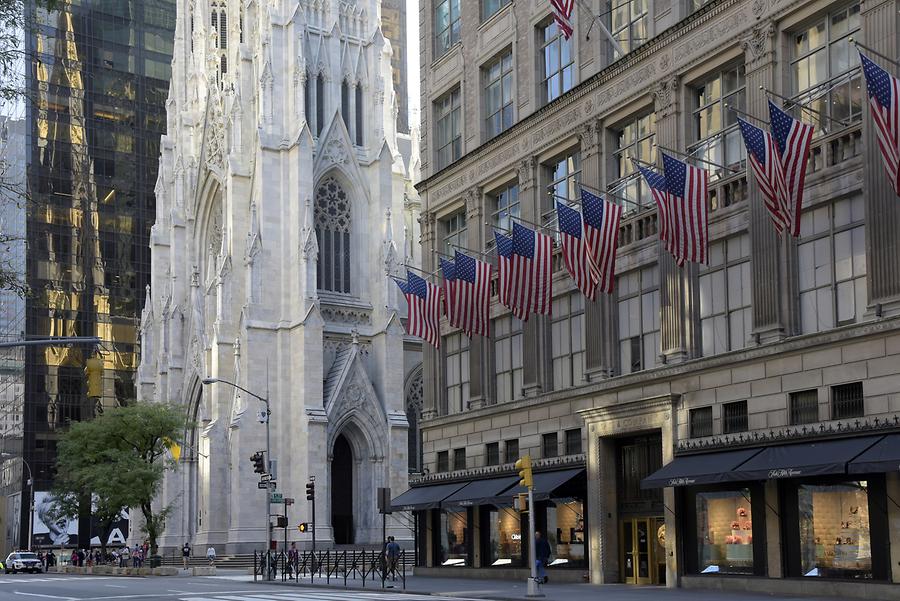Fifth Avenue#

Fifth Avenue, August 2017, © Gerhard Huber, under CC BY-NC 4.0 +Edu
1776 erklärte New York zusammen mit 12 anderen Kolonien die Unabhängigkeit von Großbritannien. Doch George Washington, der Oberbefehlshaber der Vereinigten kolonialen Streitkräfte, hatte noch 7 Jahre Krieg vor sich, bis 1783 die englischen Truppen endgültig abzogen und New York zur ersten Hauptstadt der USA wurde. Ein paar Jahre später, 1789, wählte der Kongress George Washington zum ersten Präsidenten der Vereinigten Staaten.
Auch wenn die Hauptstadtwürden bald darauf nach Philadelphia abwanderten, hat New York seine wirtschaftliche Vormachtstellung niemals abgegeben. Schon 1792 wurde die Börse in der Wallstreet gegründet. Trotz vieler Rückschläge im 19. Jahrhundert, Brandkatastrophen, Choleraepidemien und katastrophaler Armut – die Stadt war nicht kleinzukriegen. Im Gegenteil: Der Aushub des 600 km langen Erie-Kanals zwischen Hudson River und Eriesee beseitigte den chronischen Wassermangel der Stadt und brachte einen enormen wirtschaftlichen Aufschwung. Ab Mitte des 19. Jahrhunderts stieg die Bevölkerung durch Einwanderer aus Europa sprunghaft an. Iren flüchteten vor der großen Hungernot in ihrem Land, Deutsche, Italiener und Osteuropäer vor politischen Unruhen. Alle erhofften sich ein besseres Leben in der Neuen Welt, landeten aber meist in heruntergekommenen Slums. Soziale Spannungen machten die Stadt zum Hexenkessel.
Um 1860 durchstieß New York die Eine-Million-Einwohner-Grenze, 40 Jahre später waren es bereits dreieinhalb Millionen. Die Industrie und der Handel boomten bis zum großen Börsencrash von 1929. Wieder hievten Bauprogramme die Stadt aus der Krise. Die ersten Wolkenkratzer entstanden. Im zweiten Weltkrieg erlebte die Metropole abermals einen Flüchtlingsstrom, diesmal vor allem aus Nazi-Deutschland. Ab den 1970er Jahren geriet New York zunehmend in einen Strudel aus Finanzproblemen und exorbitanten Kriminalität. Viele verließen die Stadt. Die Wende kam in den 1990er Jahren mit dem populären Bürgermeister Rudolph Giuliani. Seine Null-Toleranz-Politik zeigte Erfolg. Die Kriminalität ging um ein Vielfaches zurück, sodass New York heute nicht einmal mehr unter den 200 amerikanischen Städten mit der höchsten Kriminalität aufscheint. Mit der drastisch verbesserten Sicherheitslage wurde es wieder cool, in New York zu wohnen. Seither steigt die Bevölkerung kontinuierlich an. Heute ist die Stadt ein Makrokosmos, der aus unzähligen kleinen Welten besteht, geprägt von Menschen aus allen Herren Ländern.
In 1776, New York, along with 12 other colonies, declared its independence from Great Britain. But George Washington, the commander-in-chief of the Continental Army, still had seven years to go before in 1783 the British troops finally withdrew and New York became the first capital of the US. A few years later, in 1789, the Congress constituted George Washington the first president of the United States. Even though Philadelphia was made the capital soon afterwards, New York has never given up its economic supremacy. As early as 1792, the stock exchange was founded in Wall Street. Despite many setbacks in the 19th century, fire disasters, cholera epidemics and disastrous poverty - the city was indestructible. On the contrary, the excavation of the 600-kilometer-long Erie Canal between the Hudson River and Lake Erie eliminated the city's chronic water shortage and brought a tremendous economic boom. From the middle of the 19th century, the population increased by immigrants from Europe by leaps and bounds. Irish people fled from the famine in their country, Germans, Italians and Eastern Europeans from political turmoil. Everyone hoped for a better life in the New World, but mostly ended up in run-down slums. Social tensions turned the city into a seething cauldron.
Around 1860 New York passed the mark of one million inhabitants, 40 years later it was already three and a half million. Industry and trade boomed until the great stock market crash of 1929. Again, construction programs turned the city around. The first skyscrapers were built. During World War II, the metropolis once again experienced an influx of refugees, this time mainly from Nazi Germany. As of the 1970s, New York increasingly got into financial troubles and an exorbitant level of crime. Many left the city. The turn came in the 1990s with the popular mayor Rudolph Giuliani. His zero-tolerance policy showed success. Thanks to the drop in the crime rate New York is no longer among the top 200 American cities with the highest level of crime. With the drastically improved security situation it became cool again to live in New York. Since then, the population has been rising steadily. Today, the city is a macrocosm consisting of countless small worlds shaped by people from all over the world.